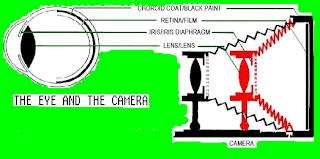Friday, August 10, 2007 ♥
THE EYE AND THE CAMERA
THE EYE AND THE CAMERA

Light is excluded or permitted to enter by the eyelids, the equivalent of the camera shutter. The iris contains the variable opening, the pupil which regulates the amount of light entering and is the aperture of a camera. The diaphragm contains the aperture of the camera, so it is similar to the iris, which contains the pupil. The lens of the eye is a biconcave, transparent structure which is responsible for focusing. The innermost coat, the retina, lies behind the lens. It contains the optic disk, or blind spot, which is the junction of nerve fibers passing to the brain. It is the counterpart of the film in a camera. The film stores the photographic chemical record of data. The lens of the camera draws the light into the camera and focuses it on the film plane. To prevent the blurring of images by internal reflection, the inner walls of the camera-- the choroid layer in a human eye-- are painted black.
